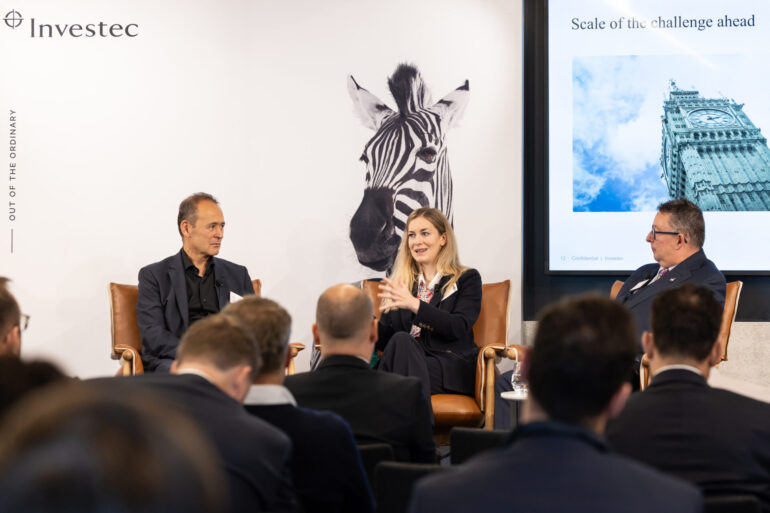Speaking about Labour’s first 100 days at an Investec event on Thursday 17th October, Phil Shaw (pictured, left), chief economist at Investec, and Lucy Fisher (pictured, centre), Financial Times Whitehall editor, examined the next steps to improving GDP growth.
Shaw said: “The Government has pledged to raise GDP growth to 2.5% per annum, and a key part of that is going to be improving investment and the infrastructure.”
The event explored the Labour Government’s key priorities and challenges, as well as the UK’s complex economic circumstances, the health of the public purse, and the potential shape of the upcoming Autumn Budget.
With just over a month left of the Labour Party’s first 100 days, the period has so far been dotted with financing black holes, tax debates, rows over public spending and peerages, NATO summits and more.
The UK economy has experienced modest growth, with GDP expected to expand by 1% to 2%, down from a pre-pandemic average of 3%.
Productivity growth remained sluggish at about 0.5% per annum.
While inflation has fallen below the 2% target, the Bank of England is concerned about persistent inflation in the service sector.
The Government aims to raise GDP growth to 2.5% per annum, focusing on infrastructure investment and a green economy.
However, significant fiscal challenges loom, with a high deficit of 4.5% of GDP and a debt-to-GDP ratio of 100%.
As the Government addresses public service funding gaps, maintaining fiscal credibility will be crucial.
Additionally, internal issues and potential external pressures, such as a possible Trump presidency, add to the uncertainties faced by the new administration as it prepares for its first budget.
Shaw said: “If you look at productivity growth, which we define as output per person, or output per hour worked, it’s risen by about half percent per annum.
“And that’s important, not least because it drives standards of living.
“Now the Government has pledged to raise GDP growth to two and a half percent per annum, and a key part of that is going to be improving investment and the infrastructure.”
He added: “We are actually looking at inflation remaining pretty close to 2% over the next year and a half or so, and that’s despite the fact that you’re getting a less negative contribution from energy over that period.
“And that’s helped by, as I said, loosening of the labour market and service sector inflation not being so much of a problem. So that should continue to ease the Bank of England’s concerns.
“There are still some doubts about what’s happening to the labour market.
“The economy’s not collapsing, so it doesn’t really seem to be much of a case for Bank of England slash interest rates, as it did at the beginning of the pandemic.
“So that says to me that what we’re going to get is a gradual series of interest rate reductions. Debt to GDP is now 100% and when labour last took office in 1997 the debt ratio was just over 30% so that’s where we’ve come.
“That fiscal position is unsustainable over the medium term.”
Fisher said: “I don’t think Labour’s economic inheritance has been too bad. It’s fiscal inheritance is another matter.
“Multiple major fiscal events now been running with historically low levels of headroom.
“It has all been pretty tight. We heard a lot from labour about this £22bn fiscal black hole that they’ve talked about inheriting.
“Some of that is from choices they’ve made. Some is undoubtedly from overall overspend from the Conservative government that came before.”
Fisher added: “Rachel Reeves believes there’s a £40bn pound funding gap, which speaks to in-year pressures, but also the fact that Jeremy Hunt had only pencilled in a 1% increase in the budgets of unprotected departments.
“Before the election, the likes of the Institute for Fiscal Studies were saying this was fanciful.
“There needs to be more money just to keep public services standing still, let alone to improve them.”
She added: “Something that is very relevant for mortgage brokers in the room is that one of the corollaries of increasing spending, even if it is for capital projects, is that that could make interest rates higher.
“And you know, there has been this Treasury model that’s come to life suggesting that for fiscal loosening of 1% of GDP that could see rates go up between 0.5 percentage points and 1.25 percentage points.
“That’s quite significant, a big increase to the cost of debt, for both consumers and businesses. So it’s not a move that’s totally without Jeopardy, even though I think broadly would be welcomed more investments in capital infrastructure.”




